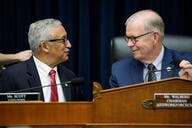You have /5 articles left.
Sign up for a free account or log in.
WASHINGTON -- The White House Saturday announced a series of tax proposals that would raise taxes on financial institutions and wealthy individuals, simplify education tax credits and pay for his plan for free community college education.
Many details were not spelled out and are expected Tuesday in the State of the Union address. Republicans were quick to oppose the tax increases (although some other parts of the plans have attracted bipartisan support in the past). The Saturday announcement caught many by surprise. Just over a week after the president proposed a plan to work with states to make community college education free for two years of study, he's back with another set of proposals focused on paying for college (as well an answer to those who said he hadn't outlined a way to pay for his community college plan).
The new proposals would:
- Raise taxes on capital gains in ways the White House says will affect only the wealthiest 1 percent of Americans.
- Impose new fees on financial institutions that borrow heavily.
- Use the billions raised by the new taxes to pay for the community college program (estimated to cost $60 billion over the next decade).
- Consolidate a series of education tax breaks into a single program to be called (as a major program is called now) the American Opportunity Tax Credit (AOTC), and make the tax credit, currently due to expire in 2017, permanent.
- Expand eligibility for the tax credit to those enrolled less than half time.
- Exempt Pell Grants from taxation (currently only the portion used for educational expenses is exempt).
- Exempt Pell Grants from the calculations of eligibility for the American Opportunity Tax Credit, which should make it possible for many more Pell-eligible students to benefit from both programs.
The White House estimated that the combined impact of the tax benefit proposals would provide students with $2,500 in educational aid a year for up to five years; the current American Opportunity Tax Credit is available for four years. The White House also projected -- without details -- that its plans would cut taxes for 8.5 million families and students and simplify taxes for the 25 million students and families who claim education tax credits.
Obama Plans on 'This Week'
This Friday, Sandy Baum of the Urban Institute and Jennifer Wang of Young Invincibles will discuss President Obama's Proposals Friday on "This Week," Inside Higher Ed's free news podcast. Sign up here to be notified of new "This Week" podcasts.
The information released by the White House Saturday night stressed ways that the plan was consistent with measures passed by the Republican-controlled House of Representatives last year. At the same time, the White House material sought to set up its tax proposals as favoring the working class and middle class, as opposed to wealthy Americans. The White House is portraying its effort to raise capital gains taxes as a proposal to close "the trust fund loophole."
Sara Goldrick-Rab, professor of education policy studies and sociology at the University of Wisconsin at Madison, who has in the past written that federal tax policies don't do enough to help low-income students and families, said via email that her first reaction to the plan was "Wow!"
"[T]his is a very smart proposal full of evidence-based solutions. I'm really happy with the [tax credit] reforms in particular," Goldrick-Rab said. (The plan would increase the refundable portion of the education tax credit, which makes it of greater help to low-income individuals. The politically popular tax credits have long been criticized by advocates for low-income students, who say they do little for needy students and are largely a giveaway to the middle- and upper-middle class.)
The White House also Saturday announced trips by President Obama this week to two college campuses where he is expected to pitch these ideas in heavily Republican states. On Wednesday, the president will be at Boise State University and on Thursday he will be at the University of Kansas.
Policy and Pragmatism
Many higher education lobbyists and experts reacted in Sunday email messages to the new proposals both on their merits (many like the goals, but some would seek to achieve them in other ways) and on their likelihood of success in Congress (most are doubtful).
Terry W. Hartle, senior vice president of government and public affairs of the American Council on Education, said that while details are still emerging, the expansion of the American Opportunity Tax Credit would be "in a direction that higher education has long advocated -- an extension to five years of eligibility, help for part time students, and an increase in refundability.
"It furthers the idea that the president sees boosting access to college as something that will be a core priority in his last two years."
But Hartle added that, politically, the proposal is "likely to be a tough climb since it's connected to the president's plan to increase taxes on the wealthy, an idea that will be DOA among Congressional Republicans."
David Baime, senior vice president for government relations and research at the American Association of Community Colleges, which has many members excited about the prospects of President Obama's community college plan, said that AACC was not taking a stand on the funding proposal. "We haven't taken a position on these revenue raisers," he said. "What we've said consistently is that we hope that Congress will make this a sufficiently high priority to identify funds. We also have pointed out that, in the overall context of the budget, this is a relatively small expenditure for something so important."
While AACC may not be weighing in on the tax increases, Baime made clear that some of the ideas in the president's plan are concepts the association strongly backs. "We care about refundability for sure, but the Pell Grant fix is much more important," he said. "Fixing that is in fact one of our highest legislative priorities. It's crazy that our Pell recipients can't get an AOTC for the most part."
Sandy Baum, a senior fellow at the Urban Institute, said while there is value in simplifying tax credits and avoiding "annual uncertainty" about whether they will last, they aren't the best way to help students. "Tax credits don’t increase enrollment as effectively as the same dollars would if devoted to need-based grant aid," she said. Many critics of the tax credits note that they do tend to help families after they have paid for college, and are of minimal help to those who lack funds to enroll in the first place.
Jason Delisle, director of the federal education budget project at the New America Foundation, had a similar reaction and suggested that there is more to be gained by a focus on Pell Grants, even if some of the tax credit proposals are logical.
"There is a big expansion of the refundable portion of AOTC, but the president could have just eliminated the refundable portion and put the money into Pell," Delisle said. "It goes to the same people and there's no extra paperwork -- he wouldn't be making low-income families hire a tax preparation company to claim their government benefits. Which brings up the next point: if there were no refundable portion of AOTC, and instead Pell was higher, then there would be no need for the White House to address the complicated interaction of the two benefits so that, again, low-income families don't need an accountant to help them optimize their federal tax credits for higher education."
Delisle added: "The president says 'rules related to Pell Grants and the AOTC are so complicated.' Well, who wrote the rules for the AOTC? The goal should be to create benefits that eliminate the need for optimizing decisions a la the Pell-AOTC interaction the Obama administration created and bemoans."
Even as some experts questioned parts of the president's proposal, as well as its odds of success in Congress, they praised him for continuing to draw attention to the need for more people to get a higher education, and for low-income people in particular to see a path to college.
Baum isn't a fan of free community college tuition either. With low tuition rates and existing federal aid, "community colleges are already free for most low- and moderate-income students. But they don’t know that," she said.
Still, all of these big proposals have real value, she said. "It’s very important to talk about big ideas and principles, even if Congress isn’t going to act on them this year," Baum said. "It’s going to take some in-depth public discussion and analysis -- and time -- to get to the point where we make meaningful changes."
Among those offering strong praise for the new Obama proposals was Jen Mishory, executive director of Young Invincibles, a group that advocates on behalf of younger Americans. In 2013, the group released an analysis of education tax credits as a means of helping people pay for college. The report faulted current programs for being too confusing and for giving away too much money to help families who could likely afford higher education without federal aid. The study specifically called for more of the AOTC to be refundable and for the program to be simplified. The report in many ways goes beyond what President Obama proposed, but his push is in the direction of the report.
Mishory's statement said: “We support President Obama’s plan to simplify higher education tax benefits; for far too long, students and their families have waded through a maze of credits and deductions that prevent many from claiming any benefits at all."




